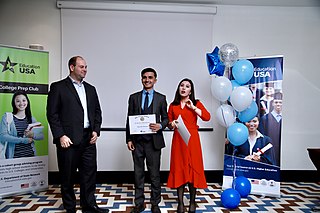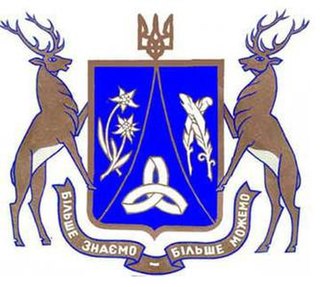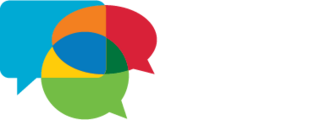
The United States Department of State (DOS), or simply the State Department, is an executive department of the U.S. federal government responsible for the country's foreign policy and relations. Equivalent to the ministry of foreign affairs of other nations, its primary duties are advising the U.S. president on international relations, administering diplomatic missions, negotiating international treaties and agreements, and representing the U.S. at the United Nations. The department is headquartered in the Harry S Truman Building, a few blocks from the White House, in the Foggy Bottom neighborhood of Washington, D.C.; "Foggy Bottom" is thus sometimes used as a metonym.

International students, or foreign students, are students who undertake all or part of their tertiary education in a country other than their own.
The Fulbright Program, including the Fulbright–Hays Program, is one of several United States Cultural Exchange Programs with the goal of improving intercultural relations, cultural diplomacy, and intercultural competence between the people of the United States and other countries through the exchange of persons, knowledge, and skills. Via the program, competitively-selected American citizens including students, scholars, teachers, professionals, scientists, and artists may receive scholarships or grants to study, conduct research, teach, or exercise their talents abroad; and citizens of other countries may qualify to do the same in the United States.
Some students from the United States pursue educational opportunities outside the United States. This can include primary, secondary and post-secondary students.
International education refers to a dynamic concept that involves a journey or movement of people, minds, or ideas across political and cultural frontiers. It is facilitated by the globalization phenomenon, which increasingly erases the constraints of geography on economic, social, and cultural arrangements. The concept involves a broad range of learning, for example, formal education and informal learning. It could also involve a reorientation of academic outlook such as the pursuit of "worldmindedness" as a goal so that a school or its academic focus is considered international. For example, the National Association of State Universities prescribes the adoption of "proper education" that reflects the full range of international, social, political, cultural, and economic dialogue. International educators are responsible for "designing, managing, and facilitating programs and activities that help participants to appropriately, effectively, and ethically engage in interactions with culturally diverse people and ideas."
For over 60 years, the Council for International Exchange of Scholars (CIES) has helped administer the Fulbright Scholar Program, the U.S. government's flagship academic exchange effort, on behalf of the United States Department of State, Bureau of Educational and Cultural Affairs. Founded in 1947, CIES is a private organization with a staff of around 60 people supplemented by 300 voluntary peer reviewers, primarily academics. CIES is a division of the Institute of International Education (IIE).

Nazareth University is a private university in Pittsford, New York. It offers over 60 undergraduate majors and more than two dozen graduate programs. The college was previously Nazareth College of Rochester, or Nazareth College.
The American University of Afghanistan (AUAF) was a private university located in the Darulaman section of Kabul. Former students of AUAF live abroad and, as of 2022, there are plans to create a new AUAF campus in Qatar. AUAF was the country's first private, not-for-profit institution of higher education and was located in Kabul near the Darul Aman Palace and the Afghan Parliament.

EducationUSA is a US Department of State network of international student advising centers in more than 170 countries. Officially a branch of the Office of Global Educational Programs, a part of the Bureau of Educational and Cultural Affairs (ECA), the ECA fosters mutual understanding between the United States and other countries by promoting personal, professional, and institutional ties between private citizens and organizations in the United States and abroad, as well as by presenting U.S. history, society, art and culture to overseas audiences.

Uzhhorod National University is a Ukrainian state higher educational institution in the city of Uzhhorod in Ukraine.
Work abroad is the term used when a student teaches, interns, or volunteers in a foreign country through a programme. Students gain work experience while being immersed in a foreign work environment, though the position may be paid or unpaid. Dependent upon the programme, a student working abroad may live in a dormitory or apartment with other students or with a "host family", a group of people who live in that country and agree to provide student lodging.

The US-UK Fulbright Commission was created by a treaty signed by the United Kingdom and the United States on 22 September, 1948. It is a non-profit organisation based in London, UK. It aims to foster mutual cultural understanding through educational exchange between both nations. Fulbright helps students, scholars and professionals interested in studying abroad in the US or UK through its scholarship programme and its EducationUSA advice service.

The Fulbright–Hays Act of 1961 is officially known as the Mutual Educational and Cultural Exchange Act of 1961. It was marshalled by United States Senator J. William Fulbright (D-AR) and passed by the 87th United States Congress on September 16, 1961, the same month the Foreign Assistance Act of 1961 and Peace Corps Act of 1961 were enacted.

The National Security Language Initiative (NSLI) is a program introduced by United States President George W. Bush on January 5, 2006 at the U.S. University President's Summit to develop the foreign language skills of American high school students, especially in "critical-need" foreign languages such as Arabic, Mandarin Chinese, Russian, Hindi, and Persian. The initiative was given $114 million in fiscal year 2007 and $26.6 million in 2008 to expand programs from kindergarten level to universities. Schools were additionally awarded $750 million for critical language education.
Student migration is the movement of students who study outside their country of birth or citizenship for a period of 12 months or more. During the period of globalization, the internationalisation of higher education increased dramatically and it has become a market driven activity. With the rapid rise of international education more and more students are seeking higher education in foreign countries and many international students now consider overseas study a stepping-stone to permanent residency within a country. The contributions that foreign students make to host nation economies, both culturally and financially has encouraged major players to implement further initiatives to facilitate the arrival and integration of overseas students, including substantial amendments to immigration and visa policies and procedures. Institutions are competing hard to attract international students at a time when immigration policies in leading destinations like the US and the UK are not enabling transition to work visas.
United States cultural exchange programs, particularly those programs with ties to the Bureau of Educational and Cultural Affairs (ECA) of the United States Department of State, seek to develop cultural understanding between United States citizens and citizens of other countries. Exchange programs do not necessarily exchange one individual for another individual of another country; rather, "exchange" refers to the exchange of cultural understanding created when an individual goes to another country. These programs can be regarded as a form of cultural diplomacy within the spectrum of public diplomacy.
The Commission for Educational Exchange between the United States of America, Belgium, and Luxembourg is located in Brussels, Belgium, with the office situated at the Royal Library Albert I. It is a not-for profit organization that is responsible for administering Fulbright grants for citizens of Belgium and Luxembourg. It also serves as the EducationUSA Advising Center in Belgium.
The Austrian-American Educational Commission/ Fulbright Austria (AAEC) is one of the 50 bi-national commissions under the Fulbright Program, which exists in order to promote “mutual understanding between the people of the United States and the peoples of other countries.”
William L. Gertz is the Chairman, President and CEO of the American Institute For Foreign Study (AIFS), a cultural exchange and educational travel company with 10 global locations, headquartered in Stamford, CT.
United States is a popular destination for international students. This can include primary, secondary and post-secondary students. Studying abroad is determined in the United States by political rationales of national security and foreign policy. The number of students studying abroad represents only about 1% of all students enrolled at institutions of higher education in the United States.








